Ford Ecosport: Engine System - General Information / General Procedures - Spark Plug Inspection
Ford Ecosport 2014-2025 Service and Repair Manual / Engine / Engine System - General Information / General Procedures - Spark Plug Inspection
Inspection
NOTE: Dropped spark plugs should always be discarded.
Unfired
-
-
An unfired spark plug should appear very clean
with a pure nickel finish to the threads and ground strap. The center
electrode ceramic insulator surface is often a matte or dull finish and
pure white in color. The external primary insulator is often a polished
white ceramic with appropriate stamping labels. Some spark plugs have a
smooth barrel while others have a ribbed barrel insulator. Ford spark
plugs almost universally use a ribbed barrel with glazed blue rib peaks.
The Anti-Fouling silicone oil treatment used on all Ford spark plugs
may be tinted pink. Some suppliers use this to designate the silicone
oil has been applied.
-
No corrective action necessary.
-
An unfired spark plug should appear very clean
with a pure nickel finish to the threads and ground strap. The center
electrode ceramic insulator surface is often a matte or dull finish and
pure white in color. The external primary insulator is often a polished
white ceramic with appropriate stamping labels. Some spark plugs have a
smooth barrel while others have a ribbed barrel insulator. Ford spark
plugs almost universally use a ribbed barrel with glazed blue rib peaks.
The Anti-Fouling silicone oil treatment used on all Ford spark plugs
may be tinted pink. Some suppliers use this to designate the silicone
oil has been applied.
 |
Normal Burning
-
-
A normal burning spark plug will often present
with a white or slightly off-white (brown or light gray) color center
electrode and clean or mildly discolored ground strap.
-
No corrective action necessary.
-
A normal burning spark plug will often present
with a white or slightly off-white (brown or light gray) color center
electrode and clean or mildly discolored ground strap.
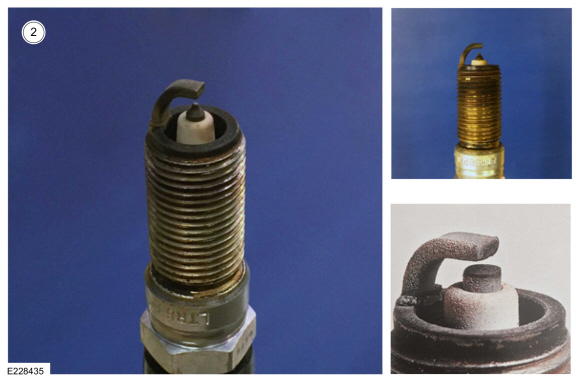 |
Carbon Fouling
-
-
Carbon fouling can cause engine misfire. As
carbon deposits, created during incomplete combustion, adhere to center
electrode insulator surfaces, insulator dielectric and isolation or
shunt resistance are compromised. In the case that sufficient carbon
deposits are present on the center electrode and insulator surface the
primary conduction path can change from spark creation to shorting
through carbon deposits. This is also known as spark leakage. Upon
shorting through carbon deposits, available voltage delivered to the
center electrode tip is reduced until no spark is delivered to the
mixture and a misfire occurs. Proper Heat Range selection is necessary
to avoid pre-ignition and carbon fouling. Even with the proper Heat
Range, avoid excessive cold starts and/or excessive idling at cold
engine temperatures without a warm-up drive cycle. For proper
self-cleaning, be sure to warm the spark plug using a medium-load drive
cycle. A normal operating temperature for a spark plug may be 450-850°C
(842-1562°F), at which point carbon deposits will burn off during spark
plug self-cleaning.
-
A drive cycle of enough distance and rpm can
clear the spark plugs of carbon fouling (ex: 4 mile drive at 3000 rpm).
-
Should this fail, install new spark plugs.
-
Carbon fouling can cause engine misfire. As
carbon deposits, created during incomplete combustion, adhere to center
electrode insulator surfaces, insulator dielectric and isolation or
shunt resistance are compromised. In the case that sufficient carbon
deposits are present on the center electrode and insulator surface the
primary conduction path can change from spark creation to shorting
through carbon deposits. This is also known as spark leakage. Upon
shorting through carbon deposits, available voltage delivered to the
center electrode tip is reduced until no spark is delivered to the
mixture and a misfire occurs. Proper Heat Range selection is necessary
to avoid pre-ignition and carbon fouling. Even with the proper Heat
Range, avoid excessive cold starts and/or excessive idling at cold
engine temperatures without a warm-up drive cycle. For proper
self-cleaning, be sure to warm the spark plug using a medium-load drive
cycle. A normal operating temperature for a spark plug may be 450-850°C
(842-1562°F), at which point carbon deposits will burn off during spark
plug self-cleaning.
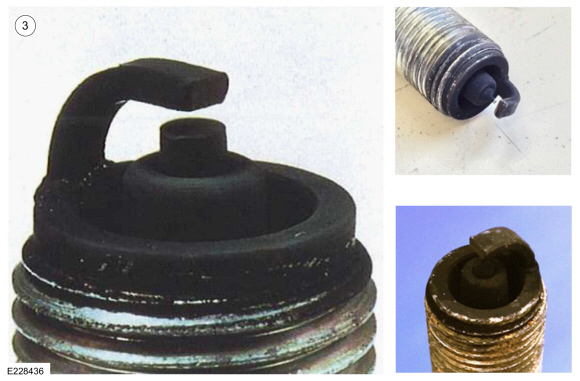 |
Lead Fouling and Erosion
-
-
Lead fouling can occur in engines that use
leaded gasoline. In modern engine applications, this failure mode is
rare, as TEL (Tetraethyllead) was removed from consumer use at fuel
filling stations long ago. Lead fouling can occur on engines used in
high compression racing engines and, in some limited cases, aviation
applications. Spark plugs that have been used in the presence of lead
are characteristically identified by a yellow/brown tinted center
electrode insulator and can cause engine misfire at high engine speed
and high load. Additionally, ground strap electrodes will often be worn
in engines exposed to leaded fuel for extended periods of time. This
failure mode is caused by the tendency for lead compounds to react
chemically with nickel electrode materials at high temperatures. These
chemical reactions often cause increased brittleness and reduced
material strength in the ground electrode.
-
Alert the customer to avoid using leaded fuel and/or octane enhancer.
-
Inspect the CMS (catalyst monitor sensor) and the HO2S for evidence of lead damage.
-
Install new spark plugs.
-
Lead fouling can occur in engines that use
leaded gasoline. In modern engine applications, this failure mode is
rare, as TEL (Tetraethyllead) was removed from consumer use at fuel
filling stations long ago. Lead fouling can occur on engines used in
high compression racing engines and, in some limited cases, aviation
applications. Spark plugs that have been used in the presence of lead
are characteristically identified by a yellow/brown tinted center
electrode insulator and can cause engine misfire at high engine speed
and high load. Additionally, ground strap electrodes will often be worn
in engines exposed to leaded fuel for extended periods of time. This
failure mode is caused by the tendency for lead compounds to react
chemically with nickel electrode materials at high temperatures. These
chemical reactions often cause increased brittleness and reduced
material strength in the ground electrode.
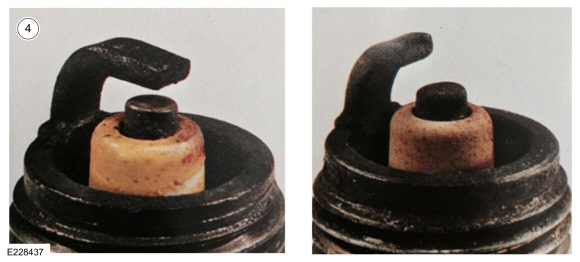 |
Coolant/Oil Wet Fouling
-
-
Wet fouling is most often caused by excess fuel,
oil, or coolant within the combustion chamber during operation. Spark
plugs that are wet fouled often cause poor starting and misfiring.
Often, a wet fouled spark plug is indicative of additional mechanical
issues within the engine system such as a compromised head gasket, oil
leakage past the control ring, or valve train leakage. In certain cases,
other causes could be low compression, vacuum leaks, overly retarded
timing, or improper spark plug heat range. The primary cause of misfire
is the low resistance path created by oil, fuel, or coolant deposits.
Wet materials provide a lower resistance path for spark leakage from the
high voltage center electrode to ground. When driving with a coolant
leak for an extended time, the plug may be cleaned.
-
Check for wet, black deposits on the insulator
shell bore electrodes, caused by excessive oil entering the combustion
chamber through worn rings and pistons, excessive valve-to-guide
clearance or worn or loose bearings.
-
Correct the coolant or oil leak concern.
-
Install new spark plugs.
-
Wet fouling is most often caused by excess fuel,
oil, or coolant within the combustion chamber during operation. Spark
plugs that are wet fouled often cause poor starting and misfiring.
Often, a wet fouled spark plug is indicative of additional mechanical
issues within the engine system such as a compromised head gasket, oil
leakage past the control ring, or valve train leakage. In certain cases,
other causes could be low compression, vacuum leaks, overly retarded
timing, or improper spark plug heat range. The primary cause of misfire
is the low resistance path created by oil, fuel, or coolant deposits.
Wet materials provide a lower resistance path for spark leakage from the
high voltage center electrode to ground. When driving with a coolant
leak for an extended time, the plug may be cleaned.
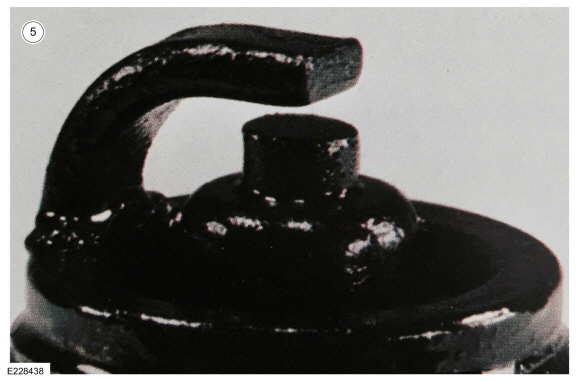 |
Deposit Buildup
-
-
The presence of deposits on the spark plug can
be indicative of oil leakage or poor fuel quality. Often, these ashy
coatings cause misfires as a low resistance path from center electrode
to ground is created.
-
Correct the oil leak, if necessary.
-
Inform the customer of possible poor quality fuel.
-
Install new spark plugs.
-
The presence of deposits on the spark plug can
be indicative of oil leakage or poor fuel quality. Often, these ashy
coatings cause misfires as a low resistance path from center electrode
to ground is created.
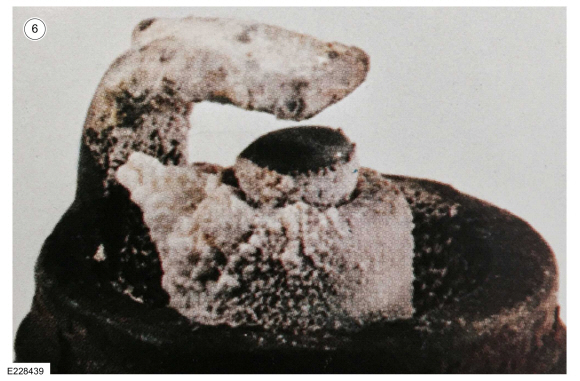 |
Abnormal Erosion/Corrosion/Oxidation
-
-
Often, eroded, corroded, or oxidized spark plug
conditions occur as a result of leaded gasoline, which reacts with
electrode materials (see Lead Fouling). These symptoms appear as pitted,
cracked, or eroded electrodes and on occasion will display with a green
cast if copper oxidation is heavy. These conditions result in
increased, improper spark plug gap and yield poor performance. More
recently, the use of Ethanol fuel blends of E85 (85% Ethanol) can create
this Oxidation condition. The Heat Range selection for E85 applications
typically is 1 range colder due to added spark advance used to make up
for the loss of performance. The hotter tip temperatures combined with
the rapid thermal cycle on the electrode surface initiates surface
cracks and eventual oxidation based corrosion.
-
Verify E85 isn’t being used in a vehicle not designated for E85 usage (Flex Fuel Vehicle).
-
Install new spark plugs.
-
Often, eroded, corroded, or oxidized spark plug
conditions occur as a result of leaded gasoline, which reacts with
electrode materials (see Lead Fouling). These symptoms appear as pitted,
cracked, or eroded electrodes and on occasion will display with a green
cast if copper oxidation is heavy. These conditions result in
increased, improper spark plug gap and yield poor performance. More
recently, the use of Ethanol fuel blends of E85 (85% Ethanol) can create
this Oxidation condition. The Heat Range selection for E85 applications
typically is 1 range colder due to added spark advance used to make up
for the loss of performance. The hotter tip temperatures combined with
the rapid thermal cycle on the electrode surface initiates surface
cracks and eventual oxidation based corrosion.
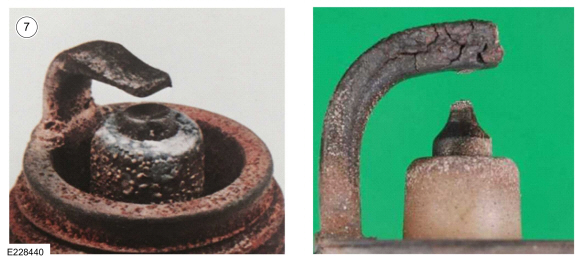 |
Ground Electrode Breakage
-
-
Ground electrode breakage can be caused by
pre-ignition or any other excess shock load. Ground electrode breaks may
be caused by incorrect ignition timing, wrong type of fuel, or
unauthorized installation of a reduced thermal conductivity Heli-Coil
insert in place of the spark plug threads.
-
Confirm the proper fuel and ignition timing.
-
Confirm the proper heat range of spark plugs.
-
Confirm that the cylinder head threads have not been repaired with a Heli-Coil thread repair kit.
-
Install new spark plugs.
-
Ground electrode breakage can be caused by
pre-ignition or any other excess shock load. Ground electrode breaks may
be caused by incorrect ignition timing, wrong type of fuel, or
unauthorized installation of a reduced thermal conductivity Heli-Coil
insert in place of the spark plug threads.
 |
MMT Fouling (Hot Plug Fouling)
-
-
MMT (Methylcyclopentadienyl Manganese
Tricarbonyl) is often used as an octane booster in combination with poor
quality fuels to bring octane levels within acceptable limits. If
excess Mn (Manganese) levels are present in the fuel during combustion,
Mn deposits can foul the combustion chamber, catalytic converters, and
spark plugs. Mn in higher concentrations can lead to pre-ignition and
engine misfire. Mn deposit become conductive as the surface exceeds
~550°C (1022°F). For this reason the failure mode is referred to as Hot
Plug Fouling. As MMT is high in manganese, a reddish coating will be
present on the spark plug insulator and ground electrodes. The reddish
coating is often covered up by carbon fouling if the spark plug is to
the point of misfire.
-
Advise the customer to avoid use of leaded fuel and/or octane enhancer.
-
Inspect the CMS and the HO2S for evidence of MMT damage.
-
Install new spark plugs.
-
MMT (Methylcyclopentadienyl Manganese
Tricarbonyl) is often used as an octane booster in combination with poor
quality fuels to bring octane levels within acceptable limits. If
excess Mn (Manganese) levels are present in the fuel during combustion,
Mn deposits can foul the combustion chamber, catalytic converters, and
spark plugs. Mn in higher concentrations can lead to pre-ignition and
engine misfire. Mn deposit become conductive as the surface exceeds
~550°C (1022°F). For this reason the failure mode is referred to as Hot
Plug Fouling. As MMT is high in manganese, a reddish coating will be
present on the spark plug insulator and ground electrodes. The reddish
coating is often covered up by carbon fouling if the spark plug is to
the point of misfire.
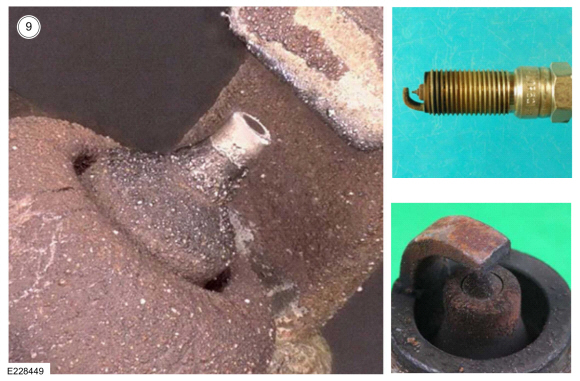 |
Ferrocene Fouling (Hot Plug Fouling)
-
-
Ferrocene (metallocene) is an organometallic
compound often used in place of MMT as an octane booster and presents
itself with a bright orange surface color. If excess ferrocene levels
are present in the fuel during combustion, ferrocene deposits can foul
the combustion chamber, catalytic converters, and spark plugs. Deposit
become conductive as the surface exceeds ~450°C (842°F). For this reason
the failure mode is referred to as Hot Plug Fouling. Ferrocene in
higher concentrations can lead to pre-ignition and engine misfire.
-
Advise the customer that they may be using leaded fuel and/or octane enhancer. Ask them to stop.
-
Inspect the CMS and the HO2S for evidence of ferrocene damage.
-
Install new spark plugs.
-
Ferrocene (metallocene) is an organometallic
compound often used in place of MMT as an octane booster and presents
itself with a bright orange surface color. If excess ferrocene levels
are present in the fuel during combustion, ferrocene deposits can foul
the combustion chamber, catalytic converters, and spark plugs. Deposit
become conductive as the surface exceeds ~450°C (842°F). For this reason
the failure mode is referred to as Hot Plug Fouling. Ferrocene in
higher concentrations can lead to pre-ignition and engine misfire.
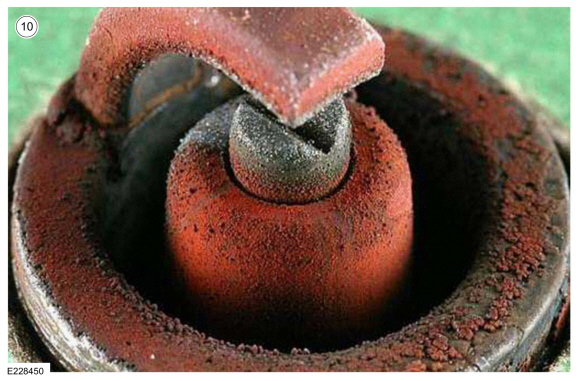 |
Overheating and Melted Electrodes
-
-
Symptoms of overheating include white or light
gray spots and a bluish-burnt appearance of the electrodes. This is
caused by engine overheating, wrong type of fuel, loose spark plugs,
spark plugs with an incorrect heat range, low fuel pump pressure, or
incorrect ignition timing. Fused deposits present with melted or spotty
deposits resembling bubbles or blisters and are indicative of sudden
acceleration.
-
Confirm proper fuel and ignition timing.
-
Confirm proper heat range of spark plugs.
-
Check the coolant system for leaks and blockages, and check water pump for malfunction.
-
Repair coolant system and refill coolant, as necessary.
-
Install new spark plugs.
-
Symptoms of overheating include white or light
gray spots and a bluish-burnt appearance of the electrodes. This is
caused by engine overheating, wrong type of fuel, loose spark plugs,
spark plugs with an incorrect heat range, low fuel pump pressure, or
incorrect ignition timing. Fused deposits present with melted or spotty
deposits resembling bubbles or blisters and are indicative of sudden
acceleration.
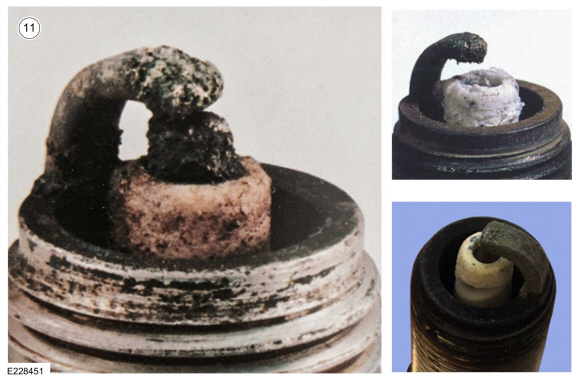 |
Insulator Damage and Breakage
-
NOTE: Upper right hand insert shows dielectric puncture typically due to excessively worn gaps.
-
Center electrode insulator breakage is often
caused by a sudden thermal shock due to sudden heating or cooling. It
can also be caused by mechanical load from an external source (droppage)
or can even be caused by pre-ignition events where side loading from
combustion pressure shock waves is strong enough to fracture the ceramic
insulator material. Hotter heat range spark plugs have a longer
insulator to reduce the spark plug fouling risk, but are also weaker to
fracture during low speed pre-ignition events due to increase bending
moment arm. Oil or Sulfur Oxide migration between the center electrode
and the inner diameter of the insulator can cause internal outward force
sufficient to create a “u” shaped fracture. See Sodium/Oil Migration
section for further detail of this failure mode.
-
Install new spark plugs.
-
Center electrode insulator breakage is often
caused by a sudden thermal shock due to sudden heating or cooling. It
can also be caused by mechanical load from an external source (droppage)
or can even be caused by pre-ignition events where side loading from
combustion pressure shock waves is strong enough to fracture the ceramic
insulator material. Hotter heat range spark plugs have a longer
insulator to reduce the spark plug fouling risk, but are also weaker to
fracture during low speed pre-ignition events due to increase bending
moment arm. Oil or Sulfur Oxide migration between the center electrode
and the inner diameter of the insulator can cause internal outward force
sufficient to create a “u” shaped fracture. See Sodium/Oil Migration
section for further detail of this failure mode.
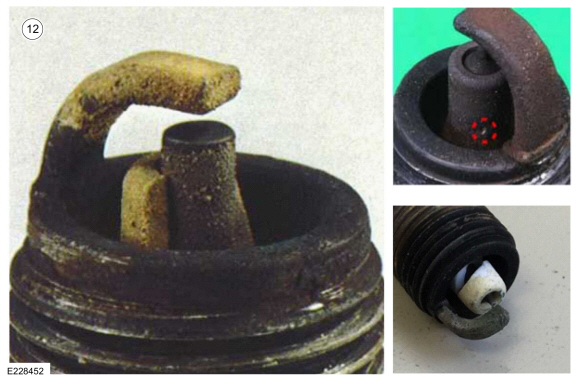 |
Sodium/Oil Migration
-
-
In the case of oil migration, misted oil is
absorbed into the combustion chamber during charge intake. For cylinder
deactivation, valves remain closed and oil within the chamber does not
combust. Misted oil adheres to the spark plug surfaces and oil
penetrates into the clearance volume between the insulator and center
electrode via capillary action. During cylinder reactivation, oil near
the surface is burned off, while soot (carbon deposits) is generated
within clearance volumes due to incomplete combustion. During spark plug
reheating, the center electrode thermally expands at a much greater
rate than the insulator, causing compressive stresses within the center
electrode and tensile stresses on the electrode insulator exterior.
These stresses can fracture the ceramic insulator if sufficiently high.
In sodium migration, sodium sulfate is created during combustion and
deposits form in the clearance volume between center electrode and
insulator. Currently, the source of sodium sulfate is not known,
although it is believed to originate from E100 fuel. Present theory
suggests that failure is caused by electrode/insulator locking, where
electrode and insulator are mechanically joined by the sodium sulfate.
During cool down, the electrode contracts and increases in diameter,
which pushes (via sodium sulfate) against the insulator and causes
failure in the same manner as seen in oil migration.
-
Install new spark plugs.
-
In the case of oil migration, misted oil is
absorbed into the combustion chamber during charge intake. For cylinder
deactivation, valves remain closed and oil within the chamber does not
combust. Misted oil adheres to the spark plug surfaces and oil
penetrates into the clearance volume between the insulator and center
electrode via capillary action. During cylinder reactivation, oil near
the surface is burned off, while soot (carbon deposits) is generated
within clearance volumes due to incomplete combustion. During spark plug
reheating, the center electrode thermally expands at a much greater
rate than the insulator, causing compressive stresses within the center
electrode and tensile stresses on the electrode insulator exterior.
These stresses can fracture the ceramic insulator if sufficiently high.
In sodium migration, sodium sulfate is created during combustion and
deposits form in the clearance volume between center electrode and
insulator. Currently, the source of sodium sulfate is not known,
although it is believed to originate from E100 fuel. Present theory
suggests that failure is caused by electrode/insulator locking, where
electrode and insulator are mechanically joined by the sodium sulfate.
During cool down, the electrode contracts and increases in diameter,
which pushes (via sodium sulfate) against the insulator and causes
failure in the same manner as seen in oil migration.
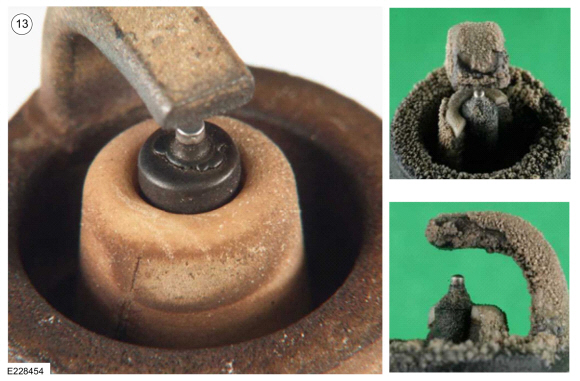 |
Bridged Gap
-
-
A bridged spark plug gap is often caused by fuel
droplets present in the ion gap when spark is commanded. The spark
event conducts through the fuel droplet leaving behind a carbon fiber.
Other contributors include deposit build up on the electrode surface
which is indicative of carbon or oil fouling. Often, this condition can
present itself after many low and medium load cycles. Carbon deposits
within the combustion chamber can break free during sudden applications
of high load, lodge within the spark plug gap, and provide a dead short
to ground.
-
Install new spark plugs.
-
A drive of between 4-10 miles targeting 3000 rpm will bring the plug to self-cleaning temperature.
-
A bridged spark plug gap is often caused by fuel
droplets present in the ion gap when spark is commanded. The spark
event conducts through the fuel droplet leaving behind a carbon fiber.
Other contributors include deposit build up on the electrode surface
which is indicative of carbon or oil fouling. Often, this condition can
present itself after many low and medium load cycles. Carbon deposits
within the combustion chamber can break free during sudden applications
of high load, lodge within the spark plug gap, and provide a dead short
to ground.
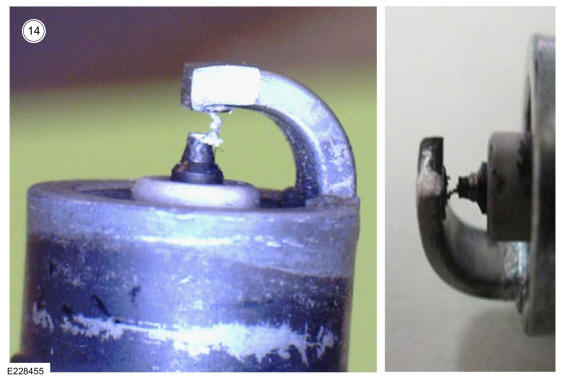 |
Wrench Breaking Cracks
-
-
Wrench breaking cracks are typically caused
either by side load or torque applied from a socket of incorrect size.
Impact loading can and will often crack the insulator shell as the
porcelain is very brittle with very little strength under tension. Force
direction is often easily determined as the ceramic often cracks
vertically (although typically asymmetric about the centerline).
-
Avoid using anything but a spark plug socket and hand tools to better prevent these cracks.
-
Install new spark plugs.
-
Wrench breaking cracks are typically caused
either by side load or torque applied from a socket of incorrect size.
Impact loading can and will often crack the insulator shell as the
porcelain is very brittle with very little strength under tension. Force
direction is often easily determined as the ceramic often cracks
vertically (although typically asymmetric about the centerline).
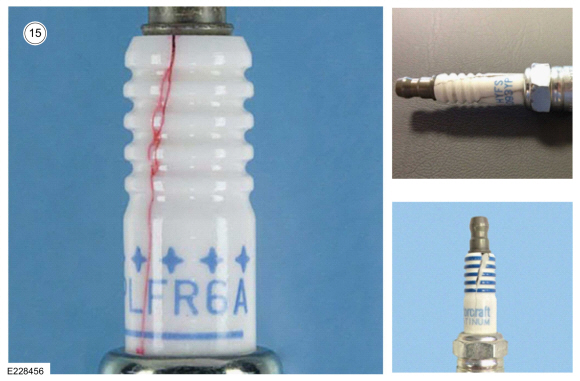 |
Tracking/Flashover
-
-
Tracking marks are markings left behind when a
high voltage discharge occurs from electrode to ground through something
other than the air gap at the spark plug end. Most often, these
discharges occur along the primarily insulator (under/near the boot) and
on the center electrode insulator. These discharges typically scorch
the porcelain ceramic and leave a brown burned visual indicator. In the
primary photo, a large brown scorch mark is apparent. In the upper
secondary photo, track marks are present along each rib. In the lower
secondary photo, which shows a case of typical carbon fouling, track
marks are present along the primary center electrode insulator as the
spark current tracked along the insulator until it jumped sideways to
the metal shell.
-
Install new spark plugs.
-
Install new ignition coil boot (if tracking is above the hex).
-
If tracking is present above the hex, both of
the above parts must be changed at the same time because the track is
present on both components. If only one is changed, the problem will
persist and a return visit is very likely.
-
Tracking marks are markings left behind when a
high voltage discharge occurs from electrode to ground through something
other than the air gap at the spark plug end. Most often, these
discharges occur along the primarily insulator (under/near the boot) and
on the center electrode insulator. These discharges typically scorch
the porcelain ceramic and leave a brown burned visual indicator. In the
primary photo, a large brown scorch mark is apparent. In the upper
secondary photo, track marks are present along each rib. In the lower
secondary photo, which shows a case of typical carbon fouling, track
marks are present along the primary center electrode insulator as the
spark current tracked along the insulator until it jumped sideways to
the metal shell.
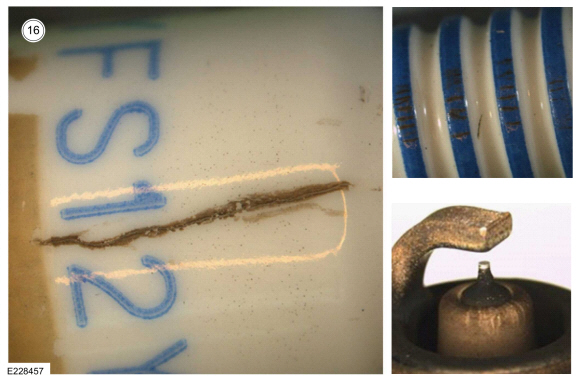 |
Corona Stain
-
-
A brown stain near where the insulator joins the
metal shell of the spark plug is often called a corona stain and is
produced when oil particles present in the air near the engine adhere to
the insulator surface. Corona discharge occurs when high voltage
applied to the conductor on top of the spark plug causes an insulation
breakdown of the air gap between the insulator and metal shell. Corona
stain does not affect spark plug performance. In the upper right
photograph, tracking marks are present indicating evidence of flash over
on ribs, but stop once the corona stain is reached. This suggests the
corona stain is not conductive, even in the presence of high kilovolts
during normal operation. The lower right photo demonstrates corona
staining on the inside of a boot.
-
No corrective action is necessary if only a corona stain is present.
-
A brown stain near where the insulator joins the
metal shell of the spark plug is often called a corona stain and is
produced when oil particles present in the air near the engine adhere to
the insulator surface. Corona discharge occurs when high voltage
applied to the conductor on top of the spark plug causes an insulation
breakdown of the air gap between the insulator and metal shell. Corona
stain does not affect spark plug performance. In the upper right
photograph, tracking marks are present indicating evidence of flash over
on ribs, but stop once the corona stain is reached. This suggests the
corona stain is not conductive, even in the presence of high kilovolts
during normal operation. The lower right photo demonstrates corona
staining on the inside of a boot.
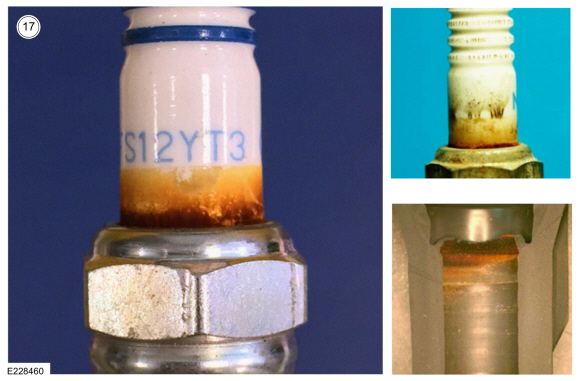 |
Center Electrode Bending/Breaking from Pre-Ignition Events (Rattler)
-
-
Under extreme pre-ignition events, a shock wave
traveling across the combustion chamber can bend the center electrode
and break the center electrode porcelain insulator. Under these extreme
circumstances, a “rattler” can be formed where the center electrode
insulation breaks free of the spark plug and rattles under vibration. In
the photos, a bent center electrode is highlighted in the main photo
while the upper secondary photo shows the fracture surface of a broken
insulator and the lower secondary photo shows a spark plug with a
detached center electrode insulator.
-
Install new spark plugs.
-
Under extreme pre-ignition events, a shock wave
traveling across the combustion chamber can bend the center electrode
and break the center electrode porcelain insulator. Under these extreme
circumstances, a “rattler” can be formed where the center electrode
insulation breaks free of the spark plug and rattles under vibration. In
the photos, a bent center electrode is highlighted in the main photo
while the upper secondary photo shows the fracture surface of a broken
insulator and the lower secondary photo shows a spark plug with a
detached center electrode insulator.
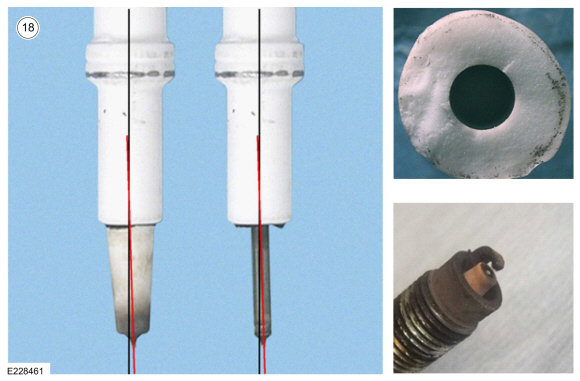 |
Corrosion (Water Damage)
-
-
Corrosion found on the wrench/threaded area can
be a sign that the spark plug has experienced moisture and heat. Often
this condition occurs when water has penetrated spark plug tube seals
and entered the spark plug tube. Many times, this corroded spark plug
also displays symptoms of misfire (as water provides a low resistance
path from high voltage coil to ground) and the combustion chamber
interface (center electrode and ground strap) will often be heavily
carbon fouled.
-
Check for the source of water intrusion and correct as necessary.
-
Install new spark plugs.
-
Install new ignition coil and boot assembly.
-
Advise the customer to avoid direct water spray on the coil boots.
-
Corrosion found on the wrench/threaded area can
be a sign that the spark plug has experienced moisture and heat. Often
this condition occurs when water has penetrated spark plug tube seals
and entered the spark plug tube. Many times, this corroded spark plug
also displays symptoms of misfire (as water provides a low resistance
path from high voltage coil to ground) and the combustion chamber
interface (center electrode and ground strap) will often be heavily
carbon fouled.
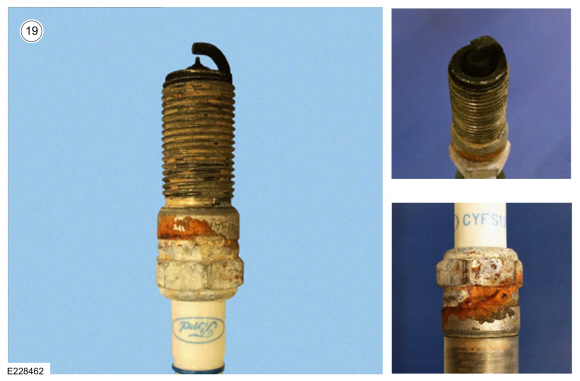 |
 General Procedures - Valve Guide Inner Diameter
General Procedures - Valve Guide Inner Diameter
Check
NOTE:
Refer to the appropriate Section 303-01 for the specification.
NOTE:
Valve guides tend to wear in an hourglass pattern...
Other information:
Ford Ecosport 2014-2025 Service and Repair Manual: Removal and Installation - Degas Bottle
Special Tool(s) / General Equipment Fluid Suction Gun Hose Clamp Remover/Installer Locking Pliers Materials Name Specification Motorcraft® Orange Prediluted Antifreeze/CoolantVC-3DIL-B WSS-M97B44-D2 Removal WARNING: Always allow the engine to cool before opening the cooling system...
Ford Ecosport 2014-2025 Service and Repair Manual: Removal and Installation - Tailgate Release Handle
Removal NOTE: Removal steps in this procedure may contain installation details. Remove the tailgate latch. Refer to: Tailgate Latch (501-14 Handles, Locks, Latches and Entry Systems, Removal and Installation). Remove the tailgate release handle...
Copyright © 2025 www.foecosport2.com


 205-153
(T80T-4000-W)
205-153
(T80T-4000-W)
 303-103
(T74P-6375-A)
303-103
(T74P-6375-A)
 303-1247
303-1247 303-15
303-15